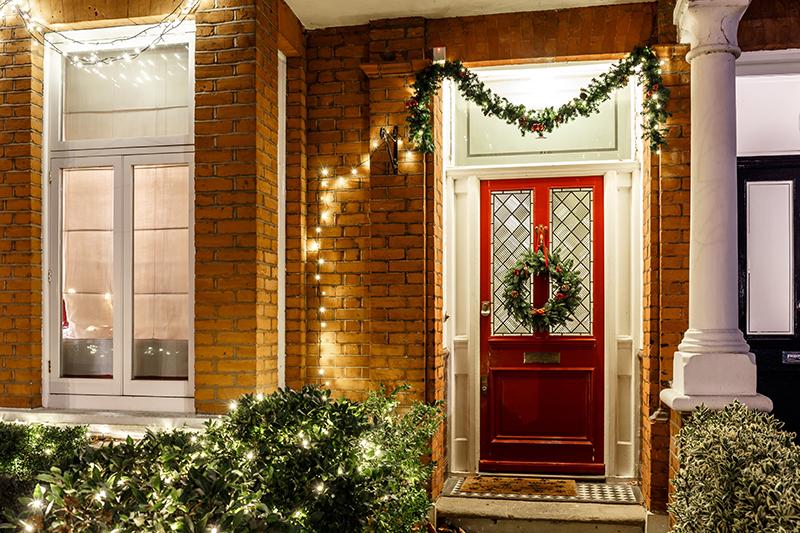Originally Published on November 24, 2021. Last Updated on May 27, 2022.
It’s that time of the year again, and maybe this holiday season, you’ve set your sights on having the best Christmas light display in the neighborhood. But before you deck the halls, roof, windows, or the front yard, let’s do a little planning.
Below are tips and tricks on how to impressively and safely decorate with Christmas lights to ensure your home looks merry and bright this holiday season.

Types of Outdoor Christmas Lights
Today, you can find just about any shape, size, and color of Christmas lights imaginable. There’s a wide variety to choose from, but these lights are some of the most popular ones:
- String lights — String lights generally cost less than other types of lights. They can also connect multiple strands for bigger decorating projects. Be sure to get string lights that come with a spool for easier management.
- Rope lights — Rope lights are perfect for outlining walkways, doorways, and windows. You can also create intricate designs and shapes with them.
- Icicle lights — Line eaves and awnings with these lights to give your home a wintery feel.
- Net lights — Ideal for trees and bushes, these lights are easy to set up and come in a variety of sizes.
- Mini lights — Mini lights feature tiny bulbs that look great wrapped around trees, columns, and railings.
- Large-bulb lights — Large-bulb lights — e.g., C5, C7, C9 — provide a strong visual impact and retro vibe. They’re perfect for roofs, walkways, and trees.
- Projection lights — These lights allow you to showcase your holiday spirit without having to put up Christmas lights.
Incandescent vs. LED Lights
Read more : The Best Freestanding Hammocks of 2023
Whatever types of lights you choose, they’ll either feature LED or incandescent bulbs. Here are the pros and cons of these lights:
- Incandescent — These lights are bright and cost-effective, but they consume a lot of energy and can heat up with extended use.
- LED — While these lights cost more than incandescent lights, they last longer and consume less energy. They stay cool and shine bright all season long.
How Much Effort Do You Want to Put In?
Before you start shopping for lights, think about how much work you want to put into hanging these lights. Remember, what you put up is going to have to come down once the holidays are over. Do you want to keep it nice and easy and line your windows with a few strands of LED lights? Or do you want to pull a Clark Griswold and cover your house with 250 strands of Italian imported twinkle lights that each have 100 individual bulbs per strand (that’s a GRAND total of 25,000 lights, by the way)? Go for it.

How Many Christmas Lights Do I Need?
Now that you’ve chosen your workload, it’s time to consider the number of lights you need.
- Start with 60 feet of string or icicle lights when decorating your home’s eaves and awnings. Add another 10 to 12 feet of lights for every eave or awning you plan to light. For a more precise calculation, grab your measuring tape and measure your eaves and awnings.
- For outdoor trees, use 100 mini lights or 50 C7 lights per vertical foot. Use half that amount for thinner trees.

Safety Tips
Read more : The 7 Best Extension Cords of 2023, According to Our Hands-On Experience
Safety first, everyone. Read these tips on how to put up Christmas lights safely:
- Use a fiberglass ladder instead of an aluminum ladder. Fiberglass ladders are resistant to electricity and heat tolerant.
- Check for burned-out bulbs. Test your lights before hanging them and replace any dead bulbs. Burned-out bulbs drain power and will dim the other bulbs in the strand.
- Don’t use nails, staples, screws, or hooks to hang Christmas lights. Light clips are a better, safer option.
- Use lights and extension cords specifically for outdoor use. Check for the UL (Underwriters Laboratories) label.
- Don’t string too many lights together. Follow the manufacturer’s instructions regarding how many strands you can safely connect.
- Don’t overload your circuit. If other lights in your house dim whenever you turn on your lights, you’re overloading your circuit.
- Avoid tripping hazards by securing your electrical cords with gaffer’s tape.
- Don’t connect LED lights with incandescent lights. The twain don’t perform well together so stick with one type.
- Always unplug your lights when not in use. Automatic light timers are highly recommended.

How to Hang Christmas Lights
Up on the Housetop
- On rooflines and awnings, use light clips to keep your lights in place and work from the top down. You can easily find light clips designed to work on any exterior surface, including gutters, windows, brickwork, and deck railings. Once you hang lights on the rooflines and awnings, secure power cords with zip ties so they don’t fall or stray.

Down on the Ground
- For pathway lights, use lawn stakes to suspend your lights along the pathway.
- For bushes and shrubs, try using net lights so you can cover a wider area with fewer strands and less work — which will leave you feeling joyful and triumphant.
- For tree branches, use lights with six to eight inches of spacing between bulbs so you can wrap them around nice and tight.

Now that you’re armed with light-hanging know-how, go forth and spread holiday cheer in your neighborhood with your Instagrammable Christmas lights display. Tag us in your photos with #loveyouroutdoors. And when the holidays are over, tell us all about it in the comments below.

SOURCES
- The Newbies Guide to Outdoor Christmas Decorating
- How to Hang Outdoor Christmas Lights Like a Pro
- 13 Expert Tips for Dazzling Christmas Lights
Source: https://gardencourte.com
Categories: Outdoor


